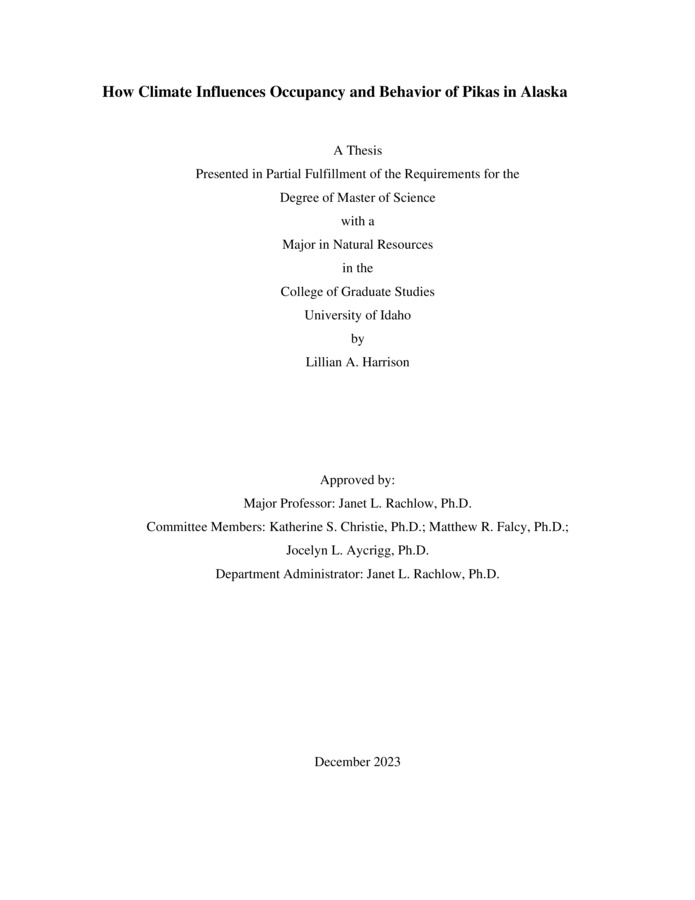How Climate Influences Occupancy and Behavior of Pikas in Alaska
Harrison, Lily Alexandria. (2023-12). How Climate Influences Occupancy and Behavior of Pikas in Alaska. Theses and Dissertations Collection, University of Idaho Library Digital Collections. https://www.lib.uidaho.edu/digital/etd/items/harrison_idaho_0089n_12729.html
- Title:
- How Climate Influences Occupancy and Behavior of Pikas in Alaska
- Author:
- Harrison, Lily Alexandria
- Date:
- 2023-12
- Keywords:
- behavior climate change foraging occupancy pika temperature
- Program:
- Natural Resources
- Subject Category:
- Wildlife conservation; Climate change; Conservation biology
- Abstract:
-
Collared pikas (Ochotona collaris) are cold adapted alpine lagomorphs of western Canada and Alaska that are vulnerable to direct and indirect effects of climate change. However, we do not yet know to what extent they can adapt to these changing climates. Collared pikas do not hibernate, so they spend the entire summer season foraging and caching vegetation within rock dens to survive winter. Our objectives were to 1) determine whether territory-specific microclimate and microhabitat characteristics influence occupancy of individual collared pika dens across years, and 2) characterize daily and seasonal foraging patterns of collared pikas to identify thermal limitations and understand how warmer conditions may affect food acquisition. We recorded den occupancy and territory characteristics, and placed temperature loggers within pika dens across 3 study areas with contrasting climate gradients in southcentral and interior Alaska, USA, during 2017-2022. We also conducted behavioral observations of collared pikas in these study areas across varying weather conditions and times of day to determine when pikas were foraging during July and August 2020-2021. We evaluated climatic conditions and habitat features to test hypotheses on den occurrence and used these data to estimate territory persistence with a Bayesian dynamic occupancy model. We tested hypotheses on proportional daily foraging activity as a function of both temporal and thermal explanatory variables through linear mixed-effects models. Daily maximum temperature during summer and winter best predicted collared pika occupancy rates, and dens with larger rocks remained cooler during summer. Foraging patterns of collared pikas were dependent on temperature, wind, and time of day, and caching behavior was dependent on a narrower range of conditions compared to grazing. These results demonstrate that specific microclimate requirements within collared pika territories, during both summer and winter, can influence territory occupancy and foraging behavior, and habitat characteristics can buffer temperature extremes. This information can advance understanding about the mechanistic links between climate and population persistence for collared pikas under the rapidly changing arctic climate.
- Description:
- masters, M.S., Natural Resources -- University of Idaho - College of Graduate Studies, 2023-12
- Major Professor:
- Rachlow, Janet L
- Committee:
- Christie, Katherine S; Falcy, Matthew R; Aycrigg, Jocelyn L
- Defense Date:
- 2023-12
- Identifier:
- Harrison_idaho_0089N_12729
- Type:
- Text
- Format Original:
- Format:
- application/pdf
- Rights:
- In Copyright - Educational Use Permitted. For more information, please contact University of Idaho Library Special Collections and Archives Department at libspec@uidaho.edu.
- Standardized Rights:
- http://rightsstatements.org/vocab/InC-EDU/1.0/

